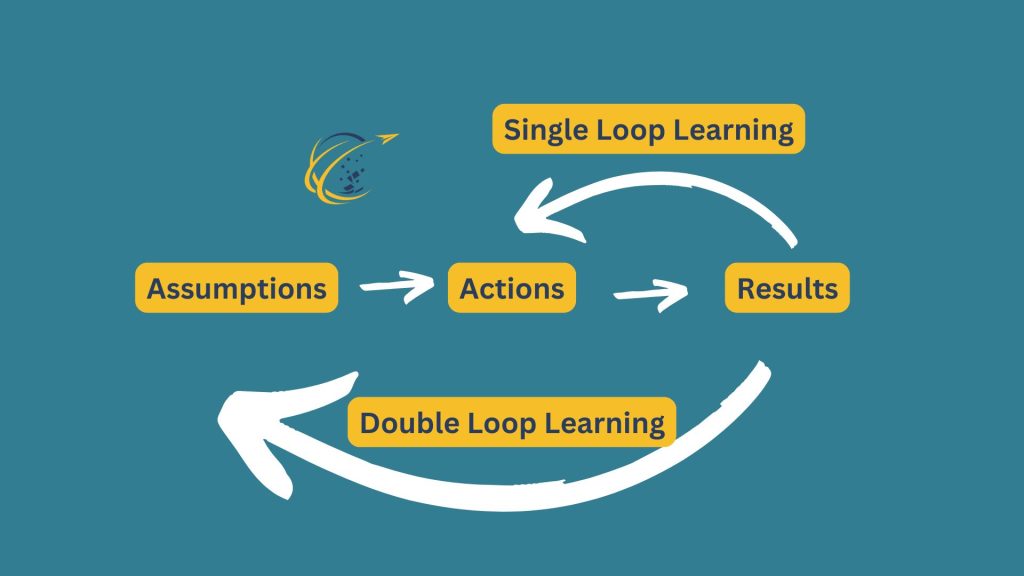
Introduction to Double Loop Learning: Concept and Importance
Double Loop Learning is a concept that goes beyond simply correcting errors. Developed by Chris Argyris in the 1970s, it encourages organizations to question their underlying assumptions. Rather than just making quick fixes, it pushes you to reflect on why a problem exists and if your current strategies align with broader goals.
In Double Loop Learning, you don’t just focus on actions; you examine the beliefs and assumptions guiding those actions. This deeper level of reflection enables your organization to adapt more effectively to complex challenges. By reassessing foundational assumptions, you can identify and address root causes of recurring issues. This process promotes greater flexibility, as it allows you to shift strategies in response to changing environments.
The importance lies in its ability to create a culture of continuous improvement. When employees at all levels engage in questioning and reflection, they contribute to a more innovative, adaptive organization. This approach helps organizations stay resilient and responsive, preparing them for long-term success in a fast-changing world.
Single Loop vs. Double Loop Learning: Understanding the Difference
Double Loop Learning and Single Loop Learning are two distinct approaches to problem-solving and organizational learning. Single Loop Learning focuses on detecting and correcting errors without questioning underlying assumptions. In this model, you make adjustments to actions or processes when an issue arises, but you don’t challenge the beliefs guiding those actions. For instance, if a product isn’t selling well, Single Loop Learning might lead you to change marketing tactics rather than examining the product’s fit with customer needs.
Double Loop Learning, on the other hand, goes a step further. Instead of only correcting actions, it encourages you to reflect on the assumptions behind those actions. In this approach, you question the very strategies, values, or policies guiding your decisions. For example, if sales are low, Double Loop Learning prompts you to ask if the product meets market demands or if the target audience needs to shift. By addressing the root cause, it fosters deeper adaptability and long-term improvement.
The key difference lies in the depth of reflection and change. While Single Loop Learning helps with immediate corrections, Double Loop Learning supports sustainable growth by encouraging broader thinking. This method builds a learning culture that doesn’t just fix problems but also seeks to understand and reshape the underlying causes, creating a more adaptive organization.
Core Principles of Double Loop Learning: Reflection and Assumption Testing
Double Loop Learning centers on two core principles: reflection and assumption testing. Unlike traditional learning models, this approach encourages you to look beyond immediate solutions. Reflection in Double Loop Learning involves examining the deeper reasons behind actions and decisions. Instead of simply correcting errors, you take time to ask why the errors occurred in the first place. By exploring these “whys,” you gain insight into the broader context, which often reveals underlying patterns that need attention.
Assumption testing is another key component. This principle asks you to question the assumptions guiding your decisions, policies, or strategies. Often, these assumptions go unchallenged, even if they no longer serve the organization effectively. Through Double Loop Learning, you regularly test these beliefs to ensure they align with current goals and realities. For example, you might ask if your product truly meets customer needs or if your organizational values support desired outcomes. This process opens the door to meaningful changes that go beyond surface-level fixes.
Together, reflection and assumption testing foster a learning culture that values deep, sustainable improvement. By practicing these principles, it enables your company to adapt and grow. This approach doesn’t just solve immediate problems; it builds a foundation for continuous learning and innovation, preparing you to respond to future challenges more effectively.
Benefits of Double Loop Learning in Organizational Decision-Making
Double Loop Learning provides significant benefits in organizational decision-making by fostering adaptability, innovation, and enhanced strategic thinking. By questioning assumptions, it helps your company respond to changes in the environment. Instead of relying on established processes, you evaluate if those processes still fit current needs. This adaptability makes it easier to pivot strategies and adjust to new market conditions or emerging challenges.
Innovation also thrives in an organization that embraces Double Loop Learning. When employees feel encouraged to question assumptions, they’re more likely to explore fresh ideas and solutions. This open approach to learning helps teams move beyond routine adjustments and think creatively about improvements. By addressing root causes rather than surface issues, it creates a space where breakthrough ideas can emerge, supporting both innovation and long-term growth.
Strategic thinking is another area where Double Loop Learning brings value. By regularly reflecting on the “why” behind decisions, your organization develops a deeper understanding of its goals and values. This reflective approach supports better-aligned strategies that serve your organization’s long-term vision. Overall, it transforms decision-making into a thoughtful, dynamic process that supports growth, innovation, and resilience in an ever-changing world.
Practical Steps to Implement Double Loop Learning in Your Organization
To implement Double Loop Learning in your organization, start by fostering a culture of inquiry. Encourage employees at all levels to ask questions about processes, goals, and decisions. By promoting curiosity, you create an environment where it’s safe to challenge assumptions. Regular discussions and open forums can help reinforce this culture, as employees feel empowered to explore the “why” behind actions.
Training for reflective thinking is another essential step. Provide employees with tools and resources that support critical thinking and self-reflection. Workshops and training sessions on reflection and assumption testing can guide your team in examining decisions more deeply. When employees develop these skills, they can better identify and address root causes instead of focusing solely on surface-level fixes.
Setting up feedback loops is also crucial. Feedback encourages ongoing dialogue and provides insights that can drive further improvement. Establish regular check-ins or debriefs where teams review decisions and outcomes, discussing what went well and what could be improved. This constant flow of feedback allows you to adjust strategies as needed, ensuring that it becomes an integral part of your organization’s growth process. With these steps, you can successfully integrate Double Loop Learning, creating a more adaptive and innovative workplace.
Challenges and Limitations
Double Loop Learning offers valuable insights, yet it also comes with challenges that may hinder its implementation. One common obstacle is resistance to change. Employees accustomed to established routines may feel uneasy when asked to question long-held assumptions. They may view this shift as disruptive or unnecessary, especially if they are comfortable with current methods. Overcoming this resistance requires patience and a strong commitment to fostering a culture of inquiry.
Another limitation is the time investment required. It involves deeper reflection and analysis, which can take more time than quick fixes. Organizations focused on immediate results may find it challenging to allocate time for continuous reflection and assumption testing. However, while time-intensive, this process can lead to more sustainable improvements, which may ultimately justify the investment.
Strong communication is also essential for successful Double Loop Learning. Without clear and open communication, teams may struggle to share insights and provide constructive feedback. Establishing feedback loops and regular check-ins requires dedication and structure, as well as the willingness of all team members to participate. Addressing these challenges thoughtfully can help you fully integrate it into your organization, making it a valuable tool for long-term growth and adaptability.
Conclusion
Double Loop Learning provides a powerful approach to fostering adaptability and deeper understanding within your organization. By encouraging reflection and challenging assumptions, this method enables you to address root causes rather than surface issues. Though implementing it may require time, commitment, and effective communication, the benefits of increased innovation, strategic thinking, and sustainable growth make it worthwhile. Embracing this approach can build a culture of continuous learning, where your team is prepared to navigate complex challenges and seize new opportunities.


